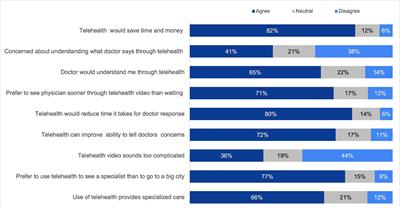Exploring behavioral intention to use telemedicine services post COVID-19: a cross sectional study in Saudi Arabia
Introduction: While telemedicine offers significant benefits, there remain substantial knowledge gaps in the literature, particularly regarding its use in Saudi Arabia.

This study aims to explore health consumers’ behavioral intention to use telemedicine examining the associated factors such as eHealth literacy and attitudes toward telemedicine services. Methods: A cross-sectional observational study was conducted to collect data on demographics, health status, internet skills, attitudes toward telemedicine, and eHealth literacy. An online survey was administered at two large public gatherings in Riyadh.
The eHEALS-Pl scale was used to measure perceived eHealth literacy levels, and data analysis was performed using SPSS (IBM Corp. United States). Results: There were 385 participants, with an equal distribution of genders.
The largest age group was 18–20 years old (57%). Nearly half of the participants were neither employed nor students, while 43% had access to governmental hospitals through employment. 71% reported proficiency in using the internet. Health-wise, 47% rated their health as excellent, and 56% did not have medical insurance. 87% expressed a high likelihood of using telemedicine if offered by a provider. Participants were categorized based on their eHealth Literacy scores, with 54% scoring low and 46% scoring high. Overall, participants showed positive attitudes toward telemedicine, with 82% agreeing that it saves time, money, and provides access to specialized care. About half of the participants perceived the process of seeing a doctor through telemedicine video as complex. Both eHealth Literacy and attitudes toward telemedicine showed a statistically significant association with the intention to use telemedicine (p < 0.001).
There was a positive and significant correlation between eHealth Literacy and attitudes (ρ =0.460; p < 0.001). Multivariate ordinal regression analysis revealed that the odds for a high likelihood of intention to use telemedicine significantly increased with positive attitudes (p < 0.001). Mediation analysis confirmed the significant mediating role of attitudes toward telemedicine in the relationship between eHealth Literacy and the intention to use telemedicine. Conclusion: The findings underline the importance of enhancing health literacy and consumer attitudes toward telemedicine, particularly during the healthcare digital transformation we are experiencing globally. This is crucial for promoting increased acceptance and utilization of telemedicine services beyond the COVID-19 pandemic.
Read the full article at the original website
References:
